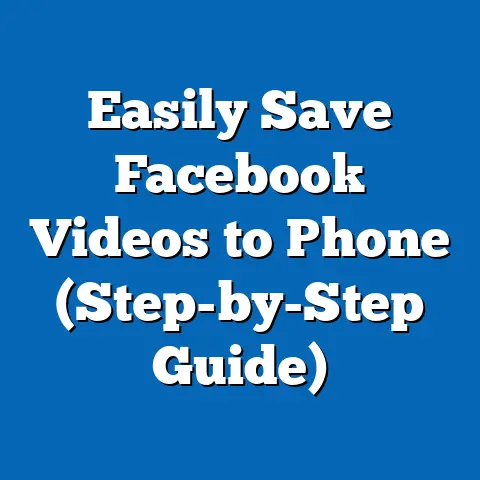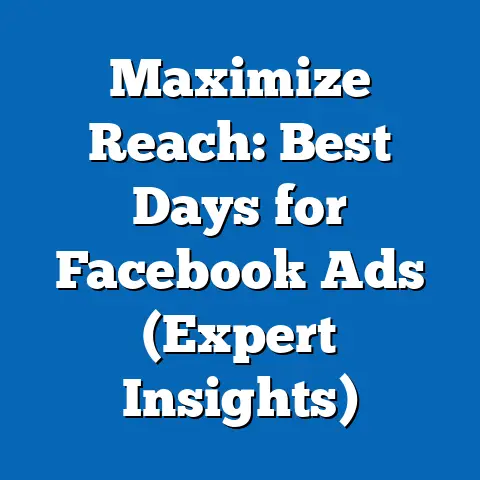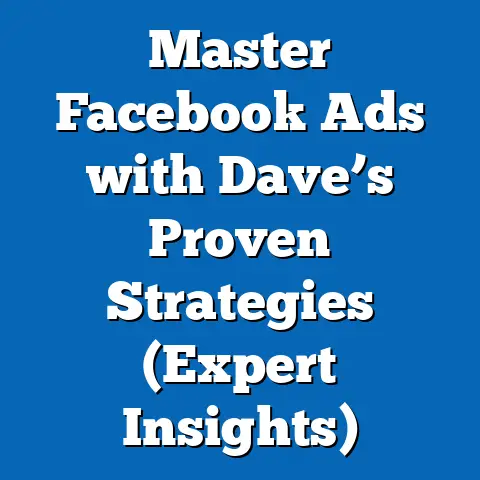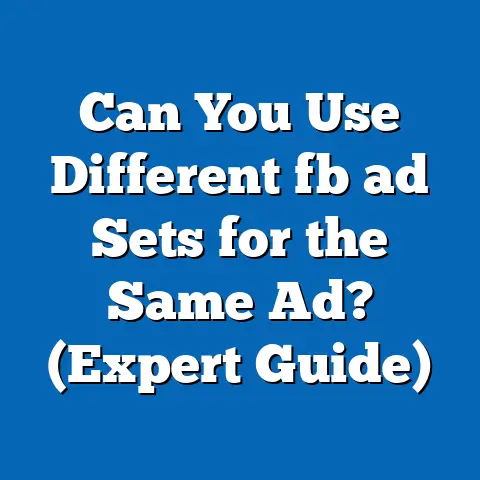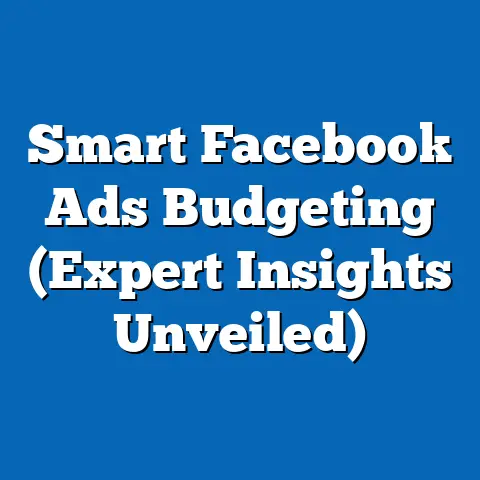Mastering Facebook Ads Manual Placement (Expert Strategies)
Facebook Ads, in my experience, are like a powerful engine for any business. They offer an easy way to reach a massive audience, but to truly harness their potential, you need to look beyond the basics. While the platform touts its user-friendliness, the real magic happens when you take control. That’s where Facebook Ads manual placement comes in. It’s more than just a setting; it’s a strategic tool that can drastically improve your campaign performance.
Section 1: Understanding Facebook Ads Manual Placement
To truly appreciate the power of manual placement, it’s essential to understand what it is and how it differs from automatic placement. Think of it this way: automatic placement is like letting Facebook decide where to put your message, while manual placement is like carefully selecting the perfect billboard location.
Manual Placement vs. Automatic Placement
Automatic Placement: This is the default setting in Facebook Ads Manager. When you choose automatic placement, you’re essentially telling Facebook to show your ads across all available placements (Facebook Feed, Instagram Feed, Stories, Audience Network, Messenger) based on what its algorithm believes will deliver the best results. While this can be convenient, especially for beginners, it often lacks the precision needed for optimal performance.
Manual Placement: This option puts you in the driver’s seat. You get to choose exactly where your ads appear. This allows you to tailor your ads to specific contexts and audiences, leading to more relevant and engaging experiences. For example, you might choose to focus solely on Instagram Stories for a visual-heavy campaign targeting a younger demographic.
I remember a time when I was running a campaign for a local restaurant. Initially, I used automatic placement, and the results were mediocre at best. The ads were showing everywhere, but they weren’t resonating with the right people. When I switched to manual placement and focused specifically on Facebook Feed and Instagram Feed, targeting users within a 5-mile radius of the restaurant, the campaign performance skyrocketed. We saw a significant increase in reservations and foot traffic, all thanks to the targeted approach of manual placement.
The Various Placement Options
Facebook offers a diverse range of placement options, each with its own unique characteristics and advantages. Here’s a breakdown:
- Facebook Feed: This is the classic Facebook experience, where users scroll through posts from friends, family, and businesses. Ads in the Facebook Feed appear as regular posts, blending seamlessly with the content.
- Instagram Feed: Similar to the Facebook Feed, the Instagram Feed is where users browse photos and videos from accounts they follow. Instagram Feed ads are highly visual and should be designed to capture attention quickly.
- Facebook Stories: These are short-form videos and images that disappear after 24 hours. Stories are a great way to engage users with interactive content, such as polls, quizzes, and behind-the-scenes glimpses.
- Instagram Stories: The same concept as Facebook Stories, but on Instagram. Instagram Stories ads are particularly effective for reaching a younger audience and showcasing products in a dynamic way.
- Audience Network: This is a network of third-party websites and apps where Facebook can show your ads. Audience Network placements can be useful for extending your reach beyond Facebook and Instagram, but they often require more careful monitoring to ensure brand safety and performance.
- Messenger: Facebook Messenger offers several placement options, including ads in the inbox and sponsored messages. Messenger ads can be a great way to engage users in personalized conversations and drive direct responses.
Choosing the Right Placements for Your Campaign Goals
The key to successful manual placement is aligning your placement choices with your campaign goals. Here are some examples:
- Brand Awareness: If your goal is to increase brand awareness, you might choose to focus on placements with broad reach, such as Facebook Feed and Audience Network.
- Lead Generation: For lead generation campaigns, consider placements that allow for easy form submissions, such as Facebook Lead Ads in the Facebook Feed.
- Sales: If you’re trying to drive sales, focus on placements that showcase your products effectively and include clear calls to action, such as Instagram Feed and Instagram Stories.
I once worked with an e-commerce client who was launching a new line of eco-friendly clothing. Their primary goal was to drive sales, but they also wanted to build brand awareness among environmentally conscious consumers. We decided to focus on Instagram Feed and Instagram Stories, using visually appealing ads that highlighted the sustainable materials and ethical production practices of the clothing line. We also incorporated a “Shop Now” button in the ads, making it easy for users to purchase directly from the platform. The campaign was a huge success, generating a significant increase in sales and brand awareness.
The Effectiveness of Manual Placements: Data and Insights
Don’t just take my word for it. Studies have shown that manual placement can lead to significant improvements in campaign performance.
- Increased Engagement: According to a Facebook study, ads placed in the Facebook Feed and Instagram Feed have a higher click-through rate (CTR) than ads placed in the Audience Network.
- Lower Costs: By focusing on the placements that are most relevant to your target audience, you can reduce your cost per click (CPC) and cost per acquisition (CPA).
- Better Conversions: A study by HubSpot found that businesses that use manual placement see a 20% increase in conversion rates compared to those that use automatic placement.
These statistics underscore the importance of taking control of your ad placements and tailoring them to your specific campaign goals and target audience.
Key Takeaway: Manual placement gives you the power to choose exactly where your ads appear, leading to better targeting, increased engagement, and lower costs.
Next Steps: Familiarize yourself with the different placement options available on Facebook and start thinking about how you can align them with your campaign goals.
Section 2: Setting Up Your Facebook Ads for Manual Placement
Now that you understand the importance of manual placement, let’s dive into the practical steps of setting up your Facebook Ads campaign.
Step-by-Step Guide to Setting Up Manual Placement
-
Access Ads Manager and Create a New Campaign: The first step is to log into your Facebook Ads Manager account. If you don’t have one, you’ll need to create one. Once you’re in Ads Manager, click the green “Create” button to start a new campaign.
-
Choose the Objective of the Campaign: Facebook offers a variety of campaign objectives, such as awareness, traffic, engagement, leads, app promotion, and sales. Choose the objective that aligns with your campaign goals.
-
Define Your Target Audience: This is where you define who you want to see your ads. You can target users based on demographics, interests, behaviors, and more. Take your time to carefully define your target audience, as this will have a significant impact on your campaign performance.
-
Select Manual Placements: After defining your target audience, you’ll be prompted to choose your placements. Select “Manual Placements.” This will give you the option to choose exactly where you want your ads to appear.
-
Optimize for Each Placement: Once you’ve selected manual placements, you’ll need to optimize your ads for each placement. This means creating ad creatives that are tailored to the specific context and audience of each placement. For example, you might create a short-form video for Instagram Stories and a longer-form video for Facebook Feed.
Access Ads Manager and Create a New Campaign: The first step is to log into your Facebook Ads Manager account. If you don’t have one, you’ll need to create one. Once you’re in Ads Manager, click the green “Create” button to start a new campaign.
Choose the Objective of the Campaign: Facebook offers a variety of campaign objectives, such as awareness, traffic, engagement, leads, app promotion, and sales. Choose the objective that aligns with your campaign goals.
Define Your Target Audience: This is where you define who you want to see your ads. You can target users based on demographics, interests, behaviors, and more. Take your time to carefully define your target audience, as this will have a significant impact on your campaign performance.
Select Manual Placements: After defining your target audience, you’ll be prompted to choose your placements. Select “Manual Placements.” This will give you the option to choose exactly where you want your ads to appear.
Optimize for Each Placement: Once you’ve selected manual placements, you’ll need to optimize your ads for each placement. This means creating ad creatives that are tailored to the specific context and audience of each placement. For example, you might create a short-form video for Instagram Stories and a longer-form video for Facebook Feed.
Visual Aids: Screenshots of the Setup Process
To make the setup process even easier, here are some screenshots to guide you along the way:
(Insert screenshots here showing the steps mentioned above, highlighting the key areas to click and configure.)
Best Practices for Ad Creatives with Manual Placements
Creating effective ad creatives for manual placements requires a strategic approach. Here are some best practices to keep in mind:
- Dimensions: Make sure your ad creatives are the correct dimensions for each placement. Facebook provides detailed specifications for each placement, so be sure to consult them before creating your ads.
- Formats: Experiment with different ad formats, such as images, videos, and carousels, to see what resonates best with your target audience on each placement.
- Messaging: Tailor your messaging to the specific context of each placement. For example, you might use a more informal tone in Instagram Stories and a more professional tone in Facebook Feed.
I remember a time when I was running a campaign for a clothing retailer. We created a series of ads featuring models wearing the retailer’s clothing. For Facebook Feed, we used high-quality images with detailed product descriptions. For Instagram Stories, we created short-form videos showcasing the clothing in action. The results were impressive. The Facebook Feed ads drove traffic to the retailer’s website, while the Instagram Stories ads generated a significant increase in brand awareness and engagement.
Key Takeaway: Setting up manual placements is a straightforward process, but it requires careful attention to detail. Make sure you define your target audience, choose the right placements, and optimize your ad creatives for each placement.
Next Steps: Follow the step-by-step guide above to set up your first Facebook Ads campaign with manual placement.
Section 3: Expert Strategies for Optimizing Manual Placement
Once you’ve mastered the basics of manual placement, it’s time to dive into some advanced strategies that experts use to maximize their campaign performance.
A/B Testing Different Placements
A/B testing, also known as split testing, is a crucial technique for optimizing your manual placements. It involves creating two or more versions of your ad and showing them to different segments of your audience. By tracking the performance of each version, you can determine which placements are most effective for your campaign goals.
For example, you might create two versions of your ad: one that focuses on Facebook Feed and another that focuses on Instagram Feed. By comparing the results, you can see which placement generates more clicks, conversions, or engagement.
I always emphasize the importance of A/B testing to my clients. It’s the best way to identify the winning combinations of placements, ad creatives, and targeting options. I once worked with a client who was convinced that Instagram Stories was the best placement for their product. However, after running an A/B test, we discovered that Facebook Feed was actually driving more conversions at a lower cost. This insight allowed us to reallocate our budget and significantly improve the campaign’s overall performance.
Utilizing Custom Audiences
Custom audiences allow you to target specific groups of people based on their past interactions with your business. This can include website visitors, email subscribers, or users who have engaged with your Facebook page. By creating custom audiences, you can tailor your placements to specific demographics or behaviors, leading to more relevant and engaging experiences.
For example, you might create a custom audience of website visitors who have viewed a specific product page. You can then target these users with ads in the Facebook Feed or Instagram Feed, reminding them of the product they viewed and encouraging them to make a purchase.
Leveraging Retargeting Strategies
Retargeting is a powerful technique for re-engaging users who have interacted with your ads or website. By showing these users ads that are tailored to their previous actions, you can increase the likelihood of them converting into customers.
For example, you might retarget users who have added a product to their cart but haven’t completed the purchase. You can show them ads in the Facebook Feed or Instagram Feed, reminding them of the product and offering them a discount to encourage them to complete the purchase.
Timing and Scheduling Ads for Optimal Visibility
Timing is everything when it comes to advertising. By timing and scheduling your ads for optimal visibility, you can increase the likelihood of them being seen by your target audience.
For example, if you’re targeting working professionals, you might schedule your ads to run during their lunch breaks or after work hours. If you’re targeting students, you might schedule your ads to run during evenings or weekends.
I always recommend analyzing your audience’s behavior patterns to determine the best times to show your ads. Facebook Insights provides valuable data on when your audience is most active, allowing you to optimize your ad schedule accordingly.
Analyzing Performance Data to Inform Future Campaigns
By analyzing this data, you can identify which placements are performing well and which ones are not. You can then adjust your budget and targeting options accordingly, focusing on the placements that are delivering the best results.
Key Takeaway: Optimizing manual placements requires a combination of A/B testing, custom audiences, retargeting, timing, and data analysis.
Next Steps: Implement the advanced strategies discussed above in your Facebook Ads campaigns and track your results closely.
Section 4: Case Studies of Successful Campaigns Using Manual Placement
To illustrate the power of manual placement, let’s take a look at some real-world case studies of businesses that have achieved success with this strategy.
Case Study 1: E-commerce Brand Drives Sales with Instagram Stories
Objective: Increase sales of a new line of summer dresses.
Manual Placements Chosen: Instagram Stories
Strategy: The e-commerce brand created a series of visually appealing Instagram Stories ads showcasing the dresses in action. The ads featured models wearing the dresses in various summer settings, such as beaches, parks, and cafes. The ads also included a “Shop Now” button, making it easy for users to purchase directly from the platform.
Results: The Instagram Stories campaign generated a significant increase in sales of the summer dresses. The brand also saw a boost in brand awareness and engagement on Instagram.
Lessons Learned: Instagram Stories is a powerful placement for visually appealing products that resonate with a younger audience.
Case Study 2: Local Restaurant Generates Reservations with Facebook Feed
Objective: Increase reservations at a local restaurant.
Manual Placements Chosen: Facebook Feed
Strategy: The restaurant created a series of Facebook Feed ads showcasing its menu items and ambiance. The ads featured high-quality images of the food and interior, along with compelling descriptions of the dining experience. The ads also included a “Book Now” button, making it easy for users to make a reservation.
Results: The Facebook Feed campaign generated a significant increase in reservations at the restaurant. The restaurant also saw an increase in foot traffic and overall revenue.
Lessons Learned: Facebook Feed is an effective placement for reaching local customers and driving direct responses.
Case Study 3: SaaS Company Generates Leads with Facebook Lead Ads
Objective: Generate leads for a SaaS company’s software product.
Manual Placements Chosen: Facebook Feed
Strategy: The SaaS company created a series of Facebook Lead Ads in the Facebook Feed. The ads offered a free trial of the software product in exchange for users’ contact information. The Lead Ads made it easy for users to submit their information without leaving the Facebook platform.
Results: The Facebook Lead Ads campaign generated a significant number of high-quality leads for the SaaS company. The company also saw an increase in website traffic and software sign-ups.
Lessons Learned: Facebook Lead Ads are an effective placement for generating leads, especially when offering a valuable incentive in exchange for contact information.
These case studies demonstrate the versatility of manual placement and its ability to drive results across a variety of industries and campaign objectives.
Key Takeaway: Manual placement can be a game-changer for businesses that are looking to optimize their Facebook Ads campaigns.
Next Steps: Analyze the case studies above and identify strategies that you can apply to your own campaigns.
Section 5: Common Pitfalls and How to Avoid Them
While manual placement can be a powerful tool, it’s important to be aware of the common pitfalls that can derail your campaigns. Here are some mistakes to avoid:
- Neglecting to Test Placements: One of the biggest mistakes advertisers make is assuming that certain placements will work without testing them. Always A/B test different placements to see which ones are most effective for your campaign goals.
- Not Monitoring Performance: It’s crucial to monitor the performance of your ads on a regular basis. If you’re not tracking your results, you won’t know which placements are working and which ones are not.
- Ignoring Audience Insights: Facebook Insights provides valuable data on your audience’s behavior and preferences. Ignoring this data is a missed opportunity to optimize your targeting and messaging.
- Using Generic Ad Creatives: Your ad creatives should be tailored to the specific context and audience of each placement. Using generic ad creatives across all placements is a recipe for disaster.
- Overlooking Mobile Optimization: With the majority of Facebook users accessing the platform on mobile devices, it’s essential to optimize your ads for mobile viewing.
- Setting It and Forgetting It: Facebook Ads are not a “set it and forget it” solution. You need to constantly monitor your campaigns, analyze your results, and make adjustments as needed.
I’ve seen countless campaigns fail because advertisers made these common mistakes. It’s crucial to be proactive and avoid these pitfalls to ensure a smoother campaign experience and better results.
Key Takeaway: Avoiding common pitfalls is essential for maximizing the effectiveness of manual placements.
Next Steps: Review the list of common pitfalls above and make sure you’re not making any of these mistakes in your own campaigns.
Conclusion
Mastering Facebook Ads manual placement is not just about understanding the different options; it’s about developing a strategic approach to advertising that takes into account your campaign goals, target audience, and ad creatives. By taking control of your ad placements, you can significantly improve your campaign performance and drive real results for your business.
I encourage you to take action by implementing the strategies discussed in this guide and experimenting with manual placements in your own campaigns. Don’t be afraid to try new things, analyze your results, and make adjustments as needed. The key to success is to be persistent, adaptable, and always learning.
With the right knowledge, skills, and mindset, you can transform your Facebook Ads from a general broadcast into a laser-focused marketing machine. So go out there, take control of your ad placements, and unlock the full potential of Facebook advertising! I am confident that with a little practice and dedication, you can achieve great success with Facebook Ads manual placement.

